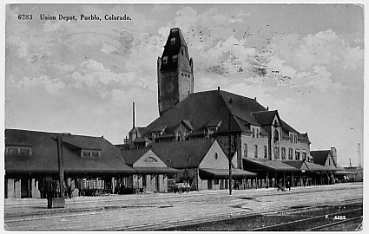
Union Stations Across the U.S.
By Beryl Frank
Pueblo, Colorado

Five railroads formed the Pueblo Union Depot & Railroad Company in 1887. They were..
These five built the Union Depot which was completed in 1890 and brought passenger service to and from the Colorado city. This service was now under one roof with trains going both in and out of Pueblo.
The depot was designed by a Chicago architectural firm - Sprague and Newell. The building had a stone exterior in the Romanesque Revival style. The stone was native Manitou red sandstone and the roof was made of heavy slate. The clock tower originally stood 150 feet high.
The first floor included waiting rooms and baggage service as well as a large restaurant (which so many union stations had) and a bakery. Mosaic tile floors, stained glass and wrought iron lamps were used to decorate the first floor.
The second floor was used for railroad offices and the third floor had some hotel rooms for the use of overnight passengers. The clock tower could be seen from all parts of the city. The depot cost over $400,000 to build. It was truly spectacular.
All went well with the Pueblo Depot until the flood of 1921. That was when the flood waters of the Arkansas River and Fountain Creek overflowed overflowed their banks and the water rose to almost 10 feet high at the depot. Anyone caught on the second and third floors of the building had to wait there until the water receded. Nearly 100 people died in the flood and numerous residents were forced from their homes. Over 400 rail cars were destroyed - and Pueblo's clock tower was cracked.
But Pueblo, Colorado, would not let a small thing like a big flood faze its citizens. They rebuilt the city and they rebuilt the depot. The heavy slate roof was replaced and the tower was lowered 30 feet. The western face of the clock was removed as it could no longer be seen above the roof.
During World War II, as many as 40 trains a day passed through Pueblo. Literally, thousands of people came through. Both the military and regular train passengers brought prosperity to the second largest city in Colorado. But as the war ended, so did the prosperity. Train travel gave way to travel by airplane and automobile. Roads and airports were built instead of laying miles of train tracks.
In 1971, the last passenger train stopped in Pueblo. The depot was placed on the National Register of Historic Places in 1975 making it eligible for federal money for restoration. Despite this eligibility, the Union Depot still sits boarded up and quite lonely after being a landmark for over 100 years.
PUEBLO UNION DEPOT CLOCK TOWER
Joe Martellaro spent over 30 years keeping the big clock running. He climbed the narrow stairway in the depot's 110-foot tower to oil and wind the clock every eight days. He retired in 1974.
The tower originally rose 150 feet and could be seen on all four sides. It marked the center of Pueblo, Colorado. The clock was built by Seth Thomas in Connecticut 10 years before it was installed at the depot in 1890. Its bronze hands measured three feet long - longer than most professional baseball bats.
The horrendous flood of 1921 was when the Arkansas River and Fountain Creek overflowed their banks causing flood waters measuring 10 feet high. Destruction was everywhere. Even the depot's clock tower was cracked by the water. This caused the need to replace the slate roof and the tower had to be lowered 30 feet.
Many of the windows today are boarded up and we are not sure if the Westminster chimes of the clock are still ringing out on the hour. But when the trains ran on the Union Depot tracks, the Pueblo station was a hub of the city and the clock tower looked over all.
Photo (top) - A view of the depot in 1909 with the clock tower overlooking the city.
Photo (bottom) - Looking up the red sandstone of the tower showing the bricks, date and clock.

.